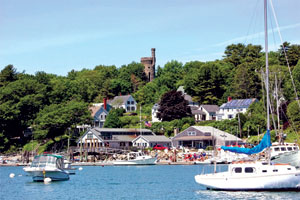Summerguide 2016 | view this story as a .pdf
Travel through Maine beauty by beauty. In the age of GPS, cultural landmarks guide you through Maine’s history.
From Staff & Wire reportd
 You’re driving down an uninspiring stretch of Route 302–just outside Windham, beyond the statue of Lenny, the 13-foot-tall TV repairman with his red lunch box at Hawkes Plaza–when you catch sight of a mirage ahead, gleaming silver in the sun. Pull closer and you’ll see the source is a low cement garage, covered entirely in polished hubcaps. Dick’s Place–part shop, part shrine to automobiles–run by local octogenarian Dick Wolstenhume, has caused rubbernecking along this stretch since 1943, when Dick’s father bought the site and started hanging up hubcaps to advertise the business. Speaking to Mainetoday.com, Wolstenhume described how the project took off organically. “People kept coming and bringing stuff in. They’re just like rabbits, they keep growing!”
You’re driving down an uninspiring stretch of Route 302–just outside Windham, beyond the statue of Lenny, the 13-foot-tall TV repairman with his red lunch box at Hawkes Plaza–when you catch sight of a mirage ahead, gleaming silver in the sun. Pull closer and you’ll see the source is a low cement garage, covered entirely in polished hubcaps. Dick’s Place–part shop, part shrine to automobiles–run by local octogenarian Dick Wolstenhume, has caused rubbernecking along this stretch since 1943, when Dick’s father bought the site and started hanging up hubcaps to advertise the business. Speaking to Mainetoday.com, Wolstenhume described how the project took off organically. “People kept coming and bringing stuff in. They’re just like rabbits, they keep growing!”
When you pass these hubcaps, you know you’re well on your way to Sebago Lake.
Ask a Mainer for directions and the response may well be peppered with colorful visual curiosities that have become part of the physical and cultural landscape.
Trying to get to South Freeport from Portland? Take a right off Route 1, just before the Freeport Big Indian. You heard right. The 30-foot-high chieftain looms over his surroundings, spear and shield at the ready. Commissioned in 1968 by Julian Leslie, then owner of Casco Bay Trading Post, the chief caused an unprecedented traffic jam on the New Jersey Turnpike a year later as he traveled by truck from Pennsylvania to Maine where he remains, stoic and imposing, to this day.
On your way to South Freeport, stay alert to spot another slice of Maine history among the trees: the turreted crown of a gray stone tower is the last vestige of the Casco Castle. Built in 1903 by entrepreneur Amos Gerald, the Casco Castle was an imposing pile of gray-shingled wood designed to resemble a turreted fortress.
Gerald hoped to increase patronage of his electric trolley line by building the castle into a resort hotel complex surrounded by an amusement park, zoo, formal gardens, and picnic grounds accessible from the Brunswick-Yarmouth Street Railway. Unfortunately the showy facade failed to attract the fashionable crowd and as the rise of the automobile led to the decline of trolleys, the hotel closed after only a few seasons. Finally, in 1914, a blaze destroyed all but the remaining stone tower.
If flashy architecture is your thing, a trip along Route 35–connecting Kennebunkport to the Maine Turnpike–will reward you with a sighting of “The Wedding Cake House,” the gabled, primrose-yellow tribute to European Gothic style that stands resplendent on Summer Street.
Designed and built in 1825 by shipbuilder George Bourne, the “Wedding Cake’”holds the title of “most-photographed house in Maine,” thanks to its intricate wooden trim and numerous buttresses and pinnacles.
As you swoop north on I-295 past Portland, you’ll find your eyes drawn to the right-hand shore. The vintage architecture, towering brick chimney, and industrial hues of the B&M Baked Bean factory are juxtaposed with the serenity of Casco Bay. Talk about retro-industrial chic. You can imagine the factory workers taking a moment to gaze out across the water in between stirring 900 pounds of beans at the brick ovens.
Wending your way into Portland’s working waterfront, you may catch sight of another industrial icon. The hand-lettered sign on this elegant brick building situated on West Commercial Street just after the Casco Bay Bridge tells of its history. The Star Match Factory was a major producer of New England’s matches from 1870 to 1908. According to the USM archives, the factory was unusual for employing a large female workforce; however, working conditions were extremely poor. Each woman was equipped with a basin holding a wet sponge to put out fires when the matches accidentally ignited, and many suffered phosphorus poisoning, which could not only damage teeth but lead to “phossy jaw,” the destruction of the jawbone. These days a number of local business inhabit sections of the complex, including Home Remedies and the World Arts Co-op, introducing their own color schemes to create a pleasing patchwork with the original russet-red paint still bookending the old factory.
Next, point your car north towards Bangor and be sure to keep an eye out for the town’s most recognizable resident. Towering 37-feet over Main Street, the legendary lumberjack, Paul Bunyan, grins down with his bushy beard and flannel shirt–a true Maine boy (although other states claim the o myth).
Bangor’s more diminutive but equally famous habitant, Stephen King, was clearly not convinced by Bunyan’s benign smile. The writer brought the legend to life in terrifying measure in his novel It. Transplanted to the fictional town of Derry, Bunyan comes to life–axe-wielding and murderous– to terrorize one of the young protagonists.
These cultural exclamation points, towering above their surroundings, have become part of the fabric of local knowledge. If you’re taking a trip to Vacationland this summer, turn off the GPS and let the landmarks guide.






0 Comments